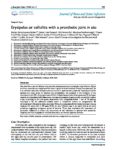Erysipelas or cellulitis with a prosthetic joint in situ
We describe a case of a 60-year old male who developed an acute prosthetic joint infection (PJI) of the knee, secondary to erysipelas of the lower leg due to beta-hemolytic Group G streptococci. As it is unknown how often this phenomenon occurs in patients with prosthetic implants and which patients are most prone to develop this complication, we analyzed: i) the incidence of the development of a PJI in these patients and ii) the clinical characteristics of streptococcal PJI during an episode of erysipelas/cellulitis. Based on a retrospective analysis of patients with a prosthetic implant in situ presenting at the emergency department with erysipelas/cellulitis, 1 out of 10 patients developed a PJI. An additional analysis within a multicenter cohort on streptococcal PJI demonstrated in 22 patients that a secondary PJI due to erysipelas/cellulitis mostly develops in young implants (<5 years old). In 20 cases (91%), the skin infection was in the same limb as the jointprosthesis suggesting contiguous spread of bacteria. These data emphasizes the importance of preventive measures to reduce the occurrence of skin infections in patients with prosthetic implants, and if an erysipelas or cellulitis does occur, to monitor patients carefully



